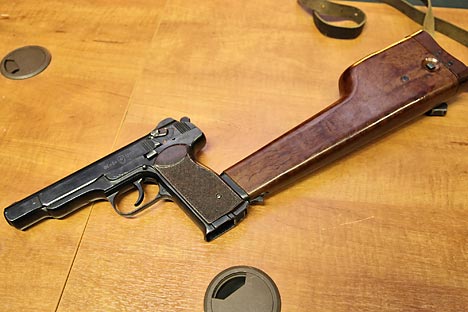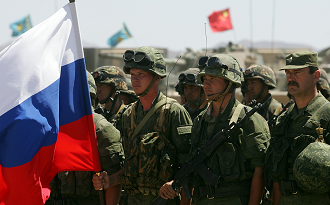Igor Stechkin’s masterpieces of weaponry

The Stechkin automatic pistol. Source: Vitaly V. Kuzmin / wikipedia.org
The most famous product of the Tula based weapons producer is the APS (Avtomaticheskiy Pistolyot Stechkina – the Stechkin automatic pistol). This gun was issued to officers, sergeants and soldiers, and to combat vehicle crews who according to regulations were not supposed to have a machine gun or a carbine submachine gun. The pistol designed at that same time by Makarov for self-defence on the battlefield proved to be woefully inadequate.
However in the 1960s the Red Army rejected the APS. The massive holster-stock appeared uncomfortable to the military, and four live magazines with 20 rounds in each were attached to the pistol, which made it even harder to carry. The trigger, which was almost perpendicular to the barrel had to be adjusted and was not really suitable for shooting off the cuff. The catch handle located underneath the gun would slow down the reloading process.
 |
| Igor Stechkin. Source: Press Photo |
Having said that Special Forces loved Stechkin’s pistol, which had minimal recoil, good operational accuracy and potent firepower. Snipers are issued with the APS in as much as its small size makes it more suitable for close combat and self-defence than the AKSU (Avtomat Kalashnikova Samokhodnaya Ustanovka – the Kalashnikov Submachine Gun). Russian pilots in Chechnya would take Stechkin’s pistol with them on combat sorties. The OMON ( Special Purpose Police Unit), SOBR (Special Rapid Reaction Unit), internal Spetsnaz forces and the GRU (Principal Intelligence Directorate), FSB (Federal Security Service) and the FSO (Federal Protection Service) all use a silent version of the APS.
The Spetsnaz appreciate Stechkin’s pistol for its accuracy, firepower, reliability, and for the opportunity to fire volleys. The police appreciate the absence of ricochet and the fact that the bullets do not pass through an assailant, which is very important in buildings or in a gathering of people.
The portable howitzer
As he spent all his life at the KBP Instrument Design Bureau in Tula, Stechkin was involved in the development of more formidable weaponry - such as the Udar-M rocket for example for the Konkurs Anti-Tank system. Following the advent of active armour for mechanised infantry, which destroyed a projectile’s cumulative stream in its terminal phase, the warhead of the Udar became tandem: the initial charge breaks through the target’s protection, while the main warhead burns through the armour to a depth of up to 800 mm and establishes a concentrated fireball inside the target.
Another feature of the rockets produced in Tula are their aerodynamic controls: they are guided not by compressed gas held in the casing but by the oncoming stream of air, for which there is an air intake in the nose section.
The police Kobalt
In 1992 designers Stechkin and Avraamov under orders from the MVD (Ministry of Internal Affairs) developed a revolver on the basis of the standard 9-mm pistol. After production of the ‘Nagany’ ceased, production of revolvers in Russia also came to an end despite their obvious advantages over pistols.
A revolver provides the potential to open fire immediately in a critical situation, while the safety lock on a pistol needs to be disengaged before the round can be fired. Revolvers do not misfire due to a round being misaligned or a mechanical failure. The use of a round designed for a pistol, which did not have a flange necessary to hold it in place and to extract the shell caused specific problems with the Kobalt, which were solved by using a clip.
Igor Yakovlevich Stechkin (1922-2001) is a famous Soviet and Russian armament designer, Laureate of the Stalin Prize (in 1952) and a cavalier of the Order of the Red Banner of Labour. He became a Designer Emeritus Russian Federation in 1992. He worked in the KBP Instrument Design Bureau in Tula from 1948. In total he produced more than 60 designs and more than 50 innovations.
The Abakan automatic weapon
Igor Stechkin, along with other well-known armament manufacturers from Tula, Izhevsk and Kovrov competed in a tender announced by the Ministry of Defence to produce a new automatic weapon with improved performance in terms of operational and firing accuracy. This was known as project Abakan.
Stechkin proposed an automatic weapon based on the bullpap design, in which the firing trigger is moved forward and is located in front of the magazine and the firing mechanism. The weapon uses 5.45-mm rounds from an AK-74. The automatic weapon is able to operate in single shot mode, or using short bursts of fire with a cut-off after every two rounds, and in fully automatic mode. It is interesting that the lever to switch between the modes has only one position for single and automatic mode, while the selection depends on how hard the trigger is squeezed. During testing Stechkin’s design demonstrated some of the best results, but in the final it conceded to a design by Gennadiy Nikonov.
First published in Russian in Rossiyskaya Gazeta.
All rights reserved by Rossiyskaya Gazeta.
Subscribe
to our newsletter!
Get the week's best stories straight to your inbox
